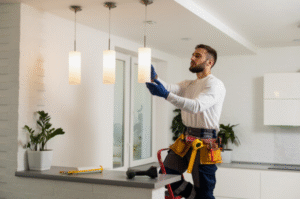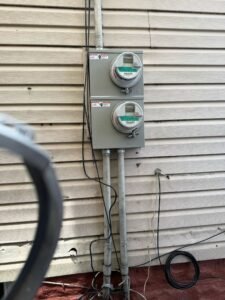Electrical Wiring Upgrade: A Smart Investment for Your Home
When was the last time you thought about your home’s electrical system? If you’re like most people, probably never. But here’s the truth: electrical wiring upgrade is not just a matter of convenience—it’s essential for your safety and the efficiency of your home. Over time, electrical wiring can deteriorate or become outdated, leading to serious problems. If you’re experiencing issues like frequent breaker trips, flickering lights, or outlets that don’t work properly, it might be time for an upgrade.
Why You Need an Electrical Wiring Upgrade
Think about the amount of energy we use in our homes today compared to 20 years ago. The increase in the number of devices—smartphones, laptops, appliances—puts more strain on your home’s wiring. If your system wasn’t built to handle today’s demands, you could be at risk for fire hazards or expensive repairs down the road. Upgrading your electrical wiring can not only improve the safety of your home but also prevent potential problems before they arise.
Prevent Electrical Hazards
Outdated or faulty wiring is one of the leading causes of electrical fires in homes. If your wiring is over 30 years old, it may not meet modern safety standards. electrical power restoration 2025 can prevent overheating, short circuits, and other issues that could lead to fires. Imagine the peace of mind you’ll have knowing your family is safe from electrical hazards.
Boost Home Efficiency
Older electrical systems may not distribute power evenly, leading to energy inefficiency. This means you could be paying higher electricity bills than necessary. By upgrading your wiring, you ensure that energy flows smoothly, reducing wastage and lowering costs in the long run.
Signs Your Home Needs an Electrical Wiring Upgrade
So, how do you know when it’s time to upgrade your wiring? Here are some signs that should raise a red flag:
1. Tripped Circuit Breakers or Blown Fuses
If you constantly find yourself resetting circuit breakers or replacing fuses, it could mean your home’s wiring system is struggling to handle the load. This is a clear sign that your electrical system needs an upgrade to keep up with modern demands.
2. Flickering or Dimming Lights
Notice your lights flickering or dimming whenever you use certain appliances? This could be due to inadequate wiring. When your home’s electrical system is outdated, it can’t always provide a steady flow of power, causing lights to behave erratically.
3. Outdated Wiring System
If your home is older and the wiring hasn’t been updated, it’s likely using outdated materials like knob-and-tube wiring or aluminum wiring. These systems are not only inefficient but also pose safety risks. Replacing them with modern copper wiring can eliminate these issues.
4. Burning Smells or Discoloration
Any burning smells or signs of discoloration around outlets or switches is a major warning sign. It usually means that your wiring is overheating, which can cause severe damage or even start a fire. In this case, an
electrical wiring in old house is a must.
Benefits of Upgrading Your Electrical Wiring
Upgrading your electrical wiring may seem like an expensive project, but it offers several long-term benefits that make it well worth the investment. Here’s why:
1. Increased Property Value
When you upgrade your home’s electrical system, you’re not just improving safety and efficiency. You’re also increasing the overall value of your property. Potential buyers will appreciate knowing that the home’s electrical system is up to code and can handle modern needs.
2. Reduced Risk of Fire
By replacing old and faulty wiring, you’re significantly lowering the risk of fire hazards. An upgrade ensures that your system is less likely to overheat or experience short circuits, keeping you and your family safe.
3. Improved Electrical Capacity
If you’re planning to add new appliances or home automation systems, your current wiring may not be able to support these additions. With an electrical wiring upgrade, you’ll have the capacity to handle new electrical loads without worrying about overloading your system.
The Electrical Wiring Upgrade Process
Wondering what’s involved in upgrading your electrical system? Here’s a general breakdown of the process:
1. Inspection and Assessment
The first step is a thorough inspection by a licensed electrician. They will assess your home’s wiring and identify any issues or areas that need upgrading. This step is crucial for determining what specific upgrades your system requires.
2. Wiring Replacement
Next, the electrician will begin replacing old or faulty wiring with new materials. In most cases, this involves installing modern copper wiring, which is safer and more efficient than older materials.
3. Electrical Panel Upgrade
In many cases, upgrading your wiring will also require replacing or upgrading your electrical panel. The panel is the heart of your system, and a modern panel ensures that electricity is distributed properly throughout your home.
4. Testing and Final Inspection
Once the upgrade is complete, the system will be tested to ensure it’s functioning correctly. A final inspection by a licensed electrician will confirm that the new wiring meets all safety codes and regulations.
Conclusion:
An residential electrical services is more than just an improvement—it’s an investment in your home’s safety, efficiency, and long-term value. If you’re experiencing any of the signs mentioned above, don’t wait until the problem escalates. Consult with a licensed electrician to assess your home’s electrical system and discuss an upgrade. Remember, a small investment now can prevent bigger problems—and costs—later.



